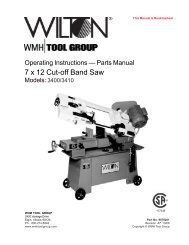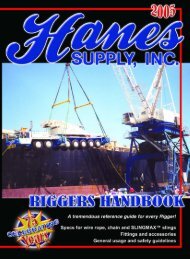Caution: This document contains mixed page sizes ... - Igor Chudov
Caution: This document contains mixed page sizes ... - Igor Chudov
Caution: This document contains mixed page sizes ... - Igor Chudov
Create successful ePaper yourself
Turn your PDF publications into a flip-book with our unique Google optimized e-Paper software.
ENGINE CONTROL SYST.EM OPERATION<br />
Dependable, trouble-free operation of the control<br />
system should be the major concern of any compe-<br />
tent generator set service personnel. Service person-<br />
nel must thoroughly understand how the controls<br />
operate, know how to check for troubles, and know<br />
how to make the proper adjustments, replacements,<br />
or repairs in a reasonable amount of time.<br />
The circuitry, control components, and operating<br />
cycles for air-cooled and marine generator sets are<br />
similar, however the gasoline and diesel-powered<br />
sets are different enough to be described separately.<br />
Prior to starting the generator set, check the fuel<br />
supply, engine oil level, and all battery connections<br />
for loose or broken wires. If an automatic demand<br />
control is in use, check for correct connections.<br />
GASOLINE POWERED SETS<br />
The DC start and run circuits are supplied by the<br />
12-volt battery and charge winding of the generator.<br />
The control circuits are completed by returning to<br />
ground (negative post of battery).<br />
Figure 73shows a typical wiring diagram for gasoline<br />
powered sets described in the following Starting,<br />
.Start-Disconnect and Stopping sequences. Relay<br />
contact references normally open (NO) and normally<br />
closed (NC) referto position of contacts with the unit<br />
at rest (not energized).<br />
Starting Sequence<br />
The Start-Stop switch is pressed and held at Start<br />
position until the engine starts and runs.<br />
Do not hold mltch longer than 30 seconds<br />
CAUT,ON Ex during any attempt to stah Longer periods<br />
my harm the starter motor and discharge battery needlettly.<br />
1. The start circuit is completed by Start-Stop<br />
switch S11 at the 'Start position. <strong>This</strong> action ener-<br />
gizes Start Relay K11 via NCcontacts of the Start-<br />
Disconnect Ignition Relay K12.<br />
2. Start Relay K11 has two sets of NO contacts per-<br />
forming the following functions when energized:<br />
a. One set connects battery B+ to: primer sole-<br />
noid K3, thermal choke S3, and starter motor<br />
shift solenoid B1.<br />
b. The other set connects B+ to: the breaker<br />
point assembly S3 (via high temperature<br />
switch S2 and NC contacts of optional Emer-<br />
gency Relay 'K14), thermal choke heater S3,<br />
and other fuel control components.<br />
58<br />
'If K14 should energize and stop the engine, a brief period is<br />
required for the relay's heater to cool before the relay con-<br />
tacts reset to the de-energlzed position for starting again.<br />
Start-Disconnect Sequence<br />
When engine speed reaches 900 rpm, centrifugal<br />
switch S1 closes. <strong>This</strong> connects B+ to the Start-<br />
Disconnect Relay K12 via resistor R1 1. The NC con-<br />
tacts of K12 now opens the K11 start circuit. The NO<br />
contacts of K12 close to connect B+ (via K14 con-<br />
tacts) to the ignition circuit and fuel control .com-<br />
ponents.<br />
Stopping Sequence<br />
Holding S11 in Stop position de-energizes K12 which<br />
opens B+ circuit to the ignition system and fuel con-<br />
trol components.<br />
DIESEL POWERED SETS<br />
The DC start and run circuits are supplied by the<br />
12-volt battery, and by the charge winding of the<br />
generator. The control circuits are completed by<br />
grounding to the negative pole of the battery.<br />
.E3<br />
CAUTION Do not apply overvoltage to the starting circuit<br />
at any time. Overvoltage will destroy the<br />
glow plugs and air heater in two to three seconds. If it becomes<br />
necessary to use an additioml source of power to star! the unituse<br />
a 12-volt battery connected in parallel with the starting<br />
bancrier.<br />
The following starting, startdisconnect and stopping<br />
sequences are referenced to the typical control<br />
schematic in Figure 74.<br />
Test reference to relay contacts normally open (NO)<br />
and normally closed (NC) refer to position of con-<br />
tacts with the unit at rest (not energized).<br />
Starting Sequence<br />
1.<br />
2.<br />
For cold engine starting, the Pre-Heat Switch S12<br />
is held in the Heat position for 30 seconds if<br />
ambient temperature is above 55OF (43OC); 60<br />
seconds if below 55OF. <strong>This</strong> action energizes the<br />
Manifold Heater Relay K13 which connects battery<br />
B+ to the manifold and glow plug heaters<br />
HRl-5.<br />
After proper pre-heat time, 512 is released and<br />
start circuit energized (Step 2).<br />
The start circuit is completed by Start-Stop<br />
Switch SI 1 at the Start position. <strong>This</strong> action energizes<br />
Start Relay K11 via NC contacts .of relay<br />
K12. Relay K13 is also energized by S11 at Start.<br />
#<br />
c<br />
.I
















